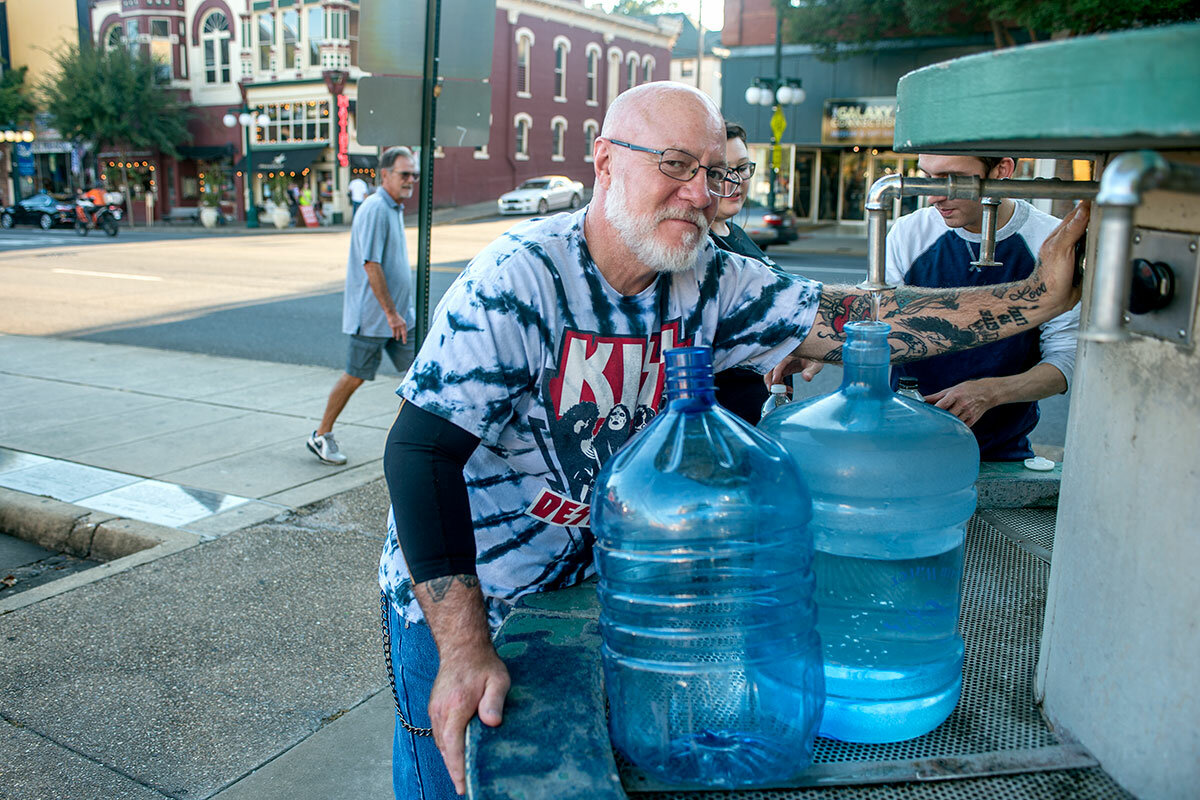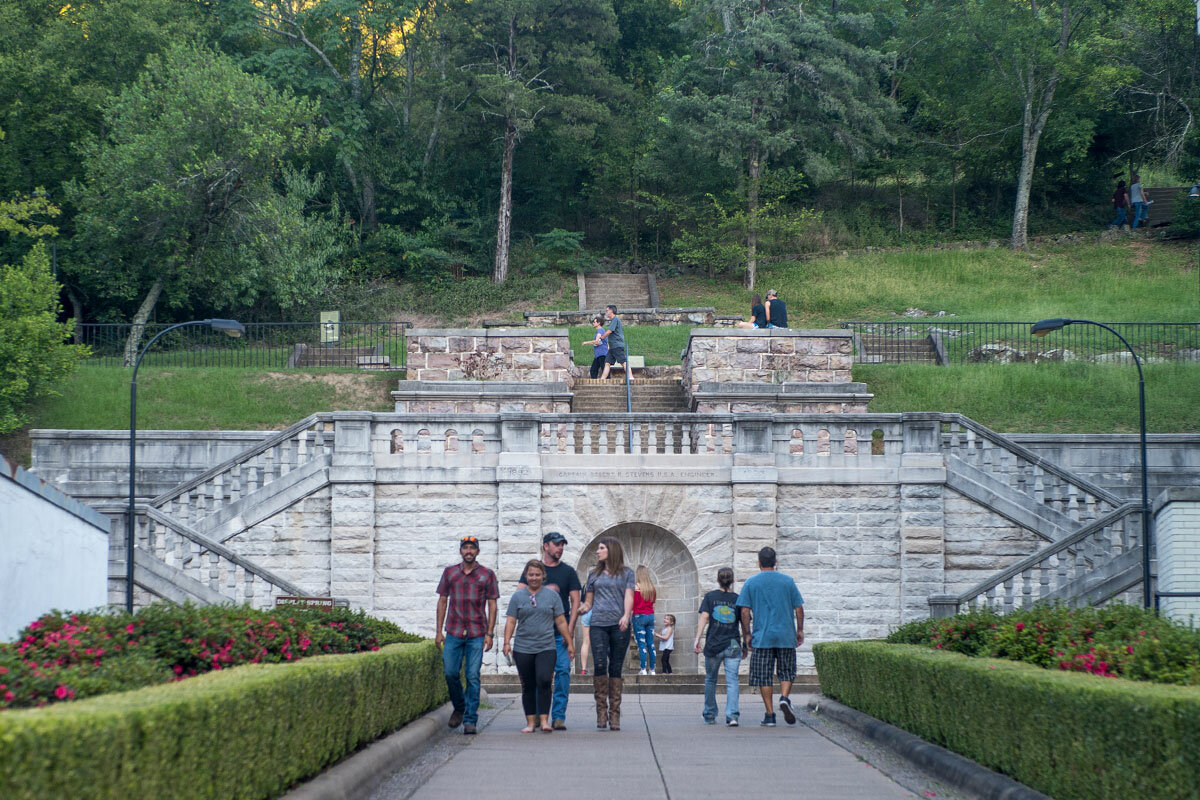Arkansas alchemy: In Hot Springs’s rebirth, a lesson for national parks
Loading...
| Hot Springs, Ark.
The rainwater that fell on Spanish explorer Hernando de Soto here in the 16th century is even now bubbling out of the ground into the historic bathhouse that Rose Schweikert has turned into a restaurant.
It has changed a lot since it first fell as rain some 4,000 years ago, picking up some carbon dioxide here, some acids and minerals there, and filtering about 7,000 feet below the Earth’s surface before shooting back up at a temperature of about 143 degrees F.
This small town nestled in the Ouachita Mountains has also changed a lot since de Soto’s time. A domain of Native American tribes, the French, and then the US, it has been a baseball haven, a gangster getaway, and a purveyor of reputedly healing water. Babe Ruth walked these streets. So did Al Capone. And so have National Park rangers, for almost a century.
Why We Wrote This
As some national parks face disengagement, decay, and financial strain, one has managed to revitalize itself in enterprising ways. What can others learn from Hot Springs National Park?
Hot Springs National Park is not one of the most iconic national parks. It’s certainly one of the smallest: just 8.5 square miles right in the middle of the city of Hot Springs, Ark. But the park, and the thermal waters beneath it, fueled the area’s growth and prosperity for a century – until it didn’t.
After decades of neglect amid a faltering local economy, the National Park Service (NPS) has capitalized on the area’s most important resource in entirely new ways, partnering with private entities to restore and reopen its eight bathhouses as private businesses.
With other low-profile national parks suffering from low visitor rates and decaying infrastructure – the national parks system as a whole is facing a maintenance backlog estimated at $11.6 billion – the renaissance Hot Springs National Park is experiencing could serve as an example for other parks to follow.
Public-private partnerships are just one of several tools to help repair and maintain national parks – an increase in funding from Congress should be the main remedy, experts and advocates say – but the success in Hot Springs shows that leasing historic buildings to private individuals or companies will likely be an important tool in the future.
“These buildings that were abandoned have been brought back to life,” says Tom Cassidy, vice president for government relations and policy at the National Trust for Historic Preservation. Historic leasing “is a very underutilized tool in the national park system, and Hot Springs is a real great example of the benefit of this program.”
Outsourcing history
Hot Springs’ slow decline began in the 1950s. Hydrotherapy had been debunked, and by 1985 seven of the eight bathhouses on Bathhouse Row had closed. The 1980s also brought a boom in suburban shopping developments, and as shoppers flocked there, businesses in Hot Springs entered a two-decade downturn.
“It was the worst time in Hot Springs history,” says Cole McCaskill, vice president of Economic Development at the Hot Springs Chamber of Commerce.
In the 1990s, at the urging of local officials and business leaders, the NPS began exploring ways to repurpose the now-vacant bathhouses.
The park service began by renovating the Fordyce Bathhouse and reopening it as a museum and visitors center in 1989. In the 2000s it began entering into historic lease agreements with private businesses for Bathhouse Row buildings.
The Quapaw Bathhouse was the first, restored and reopened as a family spa in 2008. Early 1900s tubs were replaced with modern ones, and the main room was converted into a pool area. A basement room, where the hot spring water bubbles out of the ground at 143 degrees F., was turned into a sauna.
“The town has grown tremendously [since 2008]. We get people from all over the world,” says Debi Buchta, the spa’s manager.
The 55-year lease the spa owners signed means the NPS no longer pays monthly utility bills for the building, according to the National Trust, and 2 percent of annual gross revenue goes into a fund for maintenance work.
Ms. Schweikert, an entrepreneur who led an effort to convert the Superior Bathhouse into a brewery and restaurant, estimates she is saving the park $100,000 to $200,000 a year in rent, utilities, and maintenance payments. For a park with a budget of about $4.5 million in 2014, the savings from leasing the bathhouses to eight private businesses are significant.
‘Solving real problems’
From 2013 through 2017, as more bathhouses reopened, visitors to Hot Springs National Park increased by 18 percent to more than 1.5 million people, according to the park service. The 3 million people who visited the Hot Springs metro area last year accounted for more than 10 percent of all visitors to Arkansas, and generated almost $800 million in travel spending, according to the Arkansas Department of Parks and Tourism.
These kinds of partnerships and renovations likely wouldn’t be possible without the federal historic tax credit, which gives lessees of historic buildings a 20 percent tax credit for qualified rehabilitation costs. Qualifying for a historic lease is difficult, however. The lease has to be for 55 years or more, and leasing a historic building requires compliance with strict standards set by the secretary of the Interior. It typically takes years to apply for and negotiate such a lease.
This may explain why, while the NPS says thousands of its structures could be eligible for the historic tax credit, only a half-dozen such leases across the United States have been signed using it.
It has been more than 50 years since the last major maintenance project in the national parks system – the “Mission 66” program in 1966 – and now approximately 47 percent of the $11.6 billion maintenance backlog in national parks is attributed to historic assets.
“One might say the [NPS] ought to pay for that,” says Mr. Cassidy. “I wouldn’t hold my breath.”
Instead of asking Congress to appropriate roughly $6 billion for maintenance on historic buildings, the National Trust is urging the NPS to pursue historic leasing. Real estate, says Cassidy, is a cost-effective way to focus on “solving real problems and creating successful examples, like those in Hot Springs, that can be replicated elsewhere.”
And while that would mean more private involvement in national parks, which might make some nervous, the NPS “is going to have the responsibility and the power to say, ‘Well that’s a crazy idea, we don’t want to do that,’” he adds.
Indeed, the most recent guidance from the NPS on philanthropic partnerships reiterates that naming rights, advertising, and marketing slogans are broadly prohibited. Many national parks are also so iconic they will never need private partners.
“Nobody is going to lease the Statue of Liberty, nobody is going to lease the Washington Monument,” says Cassidy. “Could there be an abuse? I suppose. I have not seen one.”
Movement in Congress
Maintenance issues across the national park system vary from rotting buildings to crumbling seawalls and eroding pipes. The problem is that annual appropriations from Congress vary as well, making it difficult for the NPS to do long-term budgeting for big maintenance projects like Mission 66.
“Parks are a popular issue [politically]. Funding is an entirely different matter,” says Marcia Argust, director of the Restore America’s Parks project at Pew Charitable Trusts.
“Taking care of national parks is the responsibility of Congress,” she adds. “But we still need to be savvy and make sure we have some reforms, some [private] partnerships in place to make sure deferred maintenance doesn’t escalate again year after year.”
Companion bills in the US House and Senate to appropriate $6.5 billion over five years to address priority repairs have been passed out of committee in recent weeks.
At the end of the day, however, the park system’s almost $12 billion maintenance backlog is roughly quadruple its annual appropriation over the past decade. Public-private partnerships like the ones in Hot Springs will almost certainly be needed to keep the system intact as it enters its second century.
In Hot Springs, at least, the partnerships are keeping the city flourishing – helping it reinvent itself with what has always been the key ingredient in its economy.
“The thermal water is the impetus, the reason why anybody is in Hot Springs today,” says Mr. McCaskill of the Hot Springs Chamber of Commerce. “As long as the hot water’s hot I think we’ll be OK.”
This story was produced with support from an Energy Foundation grant to cover the environment.
[Editor's Note: The original version of this story misstated the temperature at which the water emerges from the ground. It is 143 degrees F.]








